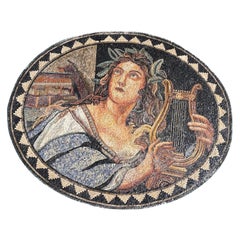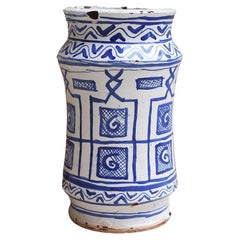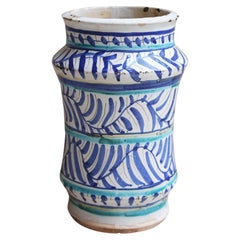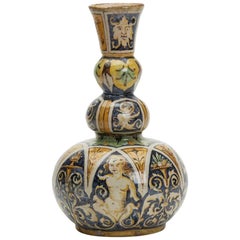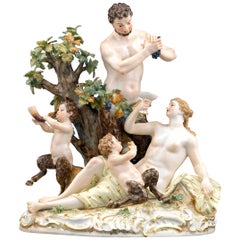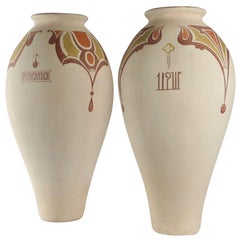Greco Roman Ceramics
3
to
2
3
3
3
3
2,906
1,297
1,092
678
358
289
187
149
87
79
67
40
27
25
8
2
2
1
2
1
1
1
3
2
2
3
3
Style: Greco Roman
Stunning Roman Mosaic style, goddess playing the harp, circa 1950.
Located in Hägersten-Liljeholmen, Stockholms län
Stunning Roman Mosaic style, goddess playing the harp, circa 1950. This stunning mosaic represent a goddess playing the hard, it is hard to date but it looks like it's a mid century work...
Category
1950s Italian Vintage Greco Roman Ceramics
Materials
Ceramic
Italian Blue and White Albarello, Late 1800s
Located in Roma, IT
A beautiful blue and white Maiolica patterned Italian Albarello, late 1800s early 1900s. Found in Palazzo Torlogna in Rome. Albarelli were ancient st...
Category
Early 19th Century Italian Antique Greco Roman Ceramics
Materials
Maiolica, Ceramic
Turquoise Maiolica Italian Albarello Late, 1800s
Located in Roma, IT
This beautiful turquoise maiolica patterned Italian albarello (late 1800s early 1900s) was found in Palazzo Torlogna in Rome. Albarelli were ancient storag...
Category
Early 19th Century Italian Antique Greco Roman Ceramics
Materials
Maiolica, Ceramic
Related Items
Majolica Oyster Plate Sarreguemines Circa 1950
Located in Austin, TX
Majolica oyster plate signed Sarreguemines, circa 1950.
4 plates are available.
Category
1950s French Vintage Greco Roman Ceramics
Materials
Ceramic, Faience
Antique Italian Maiolica Classical Painted Vase 19th Century
Located in Bishop's Stortford, Hertfordshire
A stunning and rare antique Italian Maiolica pottery triple gourd vase hand-painted with classical stylised figurative and scroll designs in typical ...
Category
19th Century Italian Antique Greco Roman Ceramics
Materials
Maiolica, Pottery
Ancient Italian Maiolica Tureen Milano, 1770 circa
Located in Milano, IT
Maiolica tureen “allo struzzo” (ostrich decoration)
Milan, Felice Clerici or Pasquale Rubati factory, circa 1750-1780
Measures: 9.25 in x 12.79 in x 10.23 in (cm 23.5 x cm 32.5 x cm 26)
lb 4.78 (kg 2.17)
State of conservation, a felûre consolidated inside with slight edge chipping restored.
In Milan in the 18th century two Majolica warehouses were opened, the first, by Felice Clerici, in 1745, the second in 1756 by Pasquale Rubati.
Traditionally this type of decoration has been attributed to the Pasquale Rubati factory. In reality the motif “allo struzzo”, one of the clearest examples of how the taste for chinoiserie met with considerable success during the 18th century, had been produced, in specimens of greater or lesser quality, by both Milanese manufactories.
This Maiolica tureen has a swollen and ribbed oval bowl, rests on an extroflexed foot and shows stirrup handles.
The tri-color ornament, in the typical tones of Japanese "Imari" decorations, shows an idealized oriental landscape that develops around a perforated rock and has a willow tree with long lance-shaped leaves framing the long-legged bird figure. The ornamentation is enhanced by decorative elements such as butterflies, small florets and a vase with a thin flowery stem.
The lid is ribbed with a pear-shaped knob on top.
The decoration was called in the Milanese manufactories "allo struzzo" (ostrich decoration) and this refers to the oriental figure Xian He or the crane, symbol of longevity, here losing its symbolic value. It is hypothesized that among some 16th century engravings...
Category
1770s Italian Antique Greco Roman Ceramics
Materials
Maiolica
Mid Century Vintage Blue and White Vase, Italy, 1960s
Located in 05-080 Hornowek, PL
Vintage glass in very good condition. The vase looks like it has just been taken out of the box. No jags, defects etc. Only one unique piece. Murano glass.
Category
Mid-20th Century Italian Greco Roman Ceramics
Materials
Glass
Majolica Doe Tureen Caugant, circa 1950
Located in Austin, TX
Rare Majolica doe tureen signed Caugant, circa 1950.
Category
1950s French Vintage Greco Roman Ceramics
Materials
Ceramic
Chinese Blue and White Porcelain Seal
Located in Chicago, IL
This small porcelain block recreates the personalized seals used to sign important documents throughout the Ming and Qing dynasties. Also known as...
Category
Mid-20th Century Chinese Greco Roman Ceramics
Materials
Porcelain
Wedgwood Jasperware Blue and White Jewelry Dish Neoclassical Style, Late 19th c
By Wedgewood
Located in New York, NY
An antique Wedgwood Jasperware blue and white oblong jewelry dish in the Neoclassical Style, circa late-19th century, England. Piece has a ...
Category
Late 19th Century English Antique Greco Roman Ceramics
Materials
Stoneware
H 0.63 in W 5.88 in D 2.32 in
Italian Maiolica Cup Ferretti Lodi, circa 1770 - 1780
Located in Milano, IT
Maiolica puerperal cup
Antonio Ferretti Manufacture
Lodi, Circa 1770 - 1780
Maiolica polychrome decorated “a piccolo fuoco” (third fire).
It measures: 4.3 x 6.8 x 5.3 in (11 x 17,5 x 13,5 cm)
Weight: 0.78 lb (358 g)
State of conservation: some closed pass-through fêlures on the cup, barely visible on the outside. Some use chips on the edge of the lid, two of which are more marked.
From about the mid-sixteenth century, the puerperal soup tureen or puerperal cup became one of the most popular wedding gifts in central Italy. As an auspicious symbol, it replaced the birth table (“desco da parto”) which, on the occasion of high-ranking marriages, from the thirteenth century, had been painted by famous artists, especially in Tuscany.
In France this same tureen is called "écuelle de mariée", as it is given to spouses as a sign of fertility.
During the eighteenth century this custom spread even outside Italy to all social levels. Depending on availability and rank, it was made of different materials: precious metals, maiolica, porcelain, glass, pewter, etc.
Beginning in the mid-twentieth century, the custom of this symbolic homage gradually disappeared, although famous designers such as Gio Ponti and Giuseppe Gariboldi, even as recently as the 1940s, revisited a model of a small puerperal soup bowl for the Ginori and, also in Italy in 1940, in a national competition for young potters, one of the themes of the test was indeed a modern model of a puerperal cup as an auspicious gift.
This particular cup was also called a "service cup" or "puerperal vase" or "stuffed cup" - the windows were sealed with straw to prevent drafts of air for women in labor.
In the eighteenth century the line of the puerpera cup was simplified, so much so that it took the form of a small tureen with two handles - the typical broth cup...
Category
1770s Italian Antique Greco Roman Ceramics
Materials
Maiolica
Italian Maiolica Ancient Sugar Bowl, Lodi, 1770-1780
Located in Milano, IT
Maiolica sugar bowl
Antonio Ferretti Manufacture
Lodi, Circa 1770-1780
Maiolica polychrome decorated “a piccolo fuoco” (third fire).
It measures 3.54 x 4.52 x 3.54 in (9 x 11,5 x 9 cm)
Weight: 0.394 lb (0.179 kg)
State of conservation: small and slight chips on the edges.
The small sugar bowl has a swollen and ribbed body resting on a flat base. The cap-shaped lid follows the rib of the container and is topped with a small knob in the shape of a two-colored fruit.
The sugar bowl is painted “a piccolo fuoco” (third fire) with the characteristic floral motif of bunches and isolated semis.
An example which closely corresponds to this one is kept at the Civic Museum in Lodi (G. Gregorietti, Maioliche di Lodi, Milano e Pavia, Catalogo della Mostra, Milano, 1964 n. 137).
This decorative style represented a strong point of the Lodi factory, which established itself thanks to the vivid nature of the colors made possible by the introduction of a new technique perfected by Paul Hannong in Strasbourg and later introduced by Antonio Ferretti to Italy. The production process, called “piccolo fuoco” (third fire), allowed the use of a greater number of colors than in the past; in particular, the purple of Cassius, a red made from gold chloride, was introduced. Its use allowed for many more tones and shades, from pink to purple.
The Ferretti family started their maiolica manufacturing business in Lodi in 1725.
The forefather Simpliciano started the business by purchasing an ancient furnace in 1725 and, indeed, we have evidence of the full activity of the furnaces starting from April of the same year (Novasconi-Ferrari-Corvi, 1964, p. 26 n. 4). Simpliciano started a production of excellence also thanks to the ownership of clay quarries in Stradella, not far from Pavia. The production was so successful that in 1726 a decree of the Turin Chamber came to prohibit the importation of foreign ceramics, especially from Lodi, to protect internal production (G. Lise, La ceramica a Lodi, Lodi 1981, p. 59).
In its initial stages, the manufacture produced maolicas painted with the “a gran fuoco” (double fire) technique, often in turquoise monochrome, with ornamentation derived from compositional modules in vogue in Rouen in France. This was also thanks to the collaboration of painters like Giorgio Giacinto Rossetti, who placed his name on the best specimens next to the initials of the factory.
In 1748 Simpliciano made his will (Gelmini, 1995, p. 30) appointing his son Giuseppe Antonio (known as Antonio) as universal heir. After 1750, when Simpliciano passed away, Antonio was directly involved in the maiolica factory, increasing its fortunes and achieving a reputation on a European level. Particularly important was the aforementioned introduction in 1760 of the innovative “a piccolo fuoco” (third fire) processing, which, expanding the ornamental repertoire with Saxon-inspired floral themes, was able to commercially compete with the German porcelains that had one of its most renowned offerings in the naturalistic Deutsche Blumen. Antonio Ferretti understood and promoted this technique and this decoration, proposing it in a fresher and more corrective version, less linked to botanical tables, both with or without contour lines, as well as in purple or green monochrome. After efforts to introduce more industrial production techniques to the sector succeeded, even the Ferretti manufacture, in the last decade of the eighteenth century, started heading towards decline despite its attempts to adapt production to neoclassical tastes.
In 1796 the Napoleonic battle for the conquest of the Lodi bridge over the Adda definitively compromised the furnaces. Production resumed, albeit in a rather stunted manner, until Antonio's death on 29 December 1810. (M. L. Gelmini, pp. 28-30, 38, 43 sgg., 130-136 (for Simpliciano); pp. 31 sgg., 45-47, 142-192 (for Antonio).
Bibliography
G. Gregorietti, Maioliche di Lodi Milano e Pavia Catalogo della Mostra, Milano, 1964 n. 137;
C. Baroni, Storia delle ceramiche nel Lodigiano, in Archivio storico per la città e i comuni del circondario e della diocesi di Lodi, XXXIV (1915), pp. 118, 124, 142; XXXV (1916), pp. 5-8;
C. Baroni, La maiolica antica di Lodi, in Archivio storico lombardo, LVIII (1931), pp. 453-455;
L. Ciboldi, La maiolica lodigiana, in Archivio storico lodigiano, LXXX (1953), pp. 25 sgg.;
S. Levy, Maioliche settecentesche lombarde e venete, Milano 1962, pp. 17 sgg.;
A. Novasconi - S. Ferrari - S. Corvi, La ceramica lodigiana, Lodi 1964, ad Indicem; Maioliche di Lodi, Milano e Pavia (catal.), Milano 1964, p. 17;
O. Ferrari - G. Scavizzi, Maioliche italiane del Seicento e del Settecento, Milano 1965, pp. 26 sgg.;
G. C. Sciolla, Lodi. Museo civico, Bologna 1977, pp. 69-85 passim; G. Lise, La ceramica a Lodi, Lodi 1981;
M. Vitali, in Storia dell'arte ceramica...
Category
1770s Italian Antique Greco Roman Ceramics
Materials
Maiolica
70-Piece Ceramic Dinner Service, San Cristoforo Richard Ginori. late 1800s
Located in Palermo, IT
70-piece ceramic dinner service, San Cristoforo Richard Ginori, made in Italy, late 1800s (1873-1896)
This company manufactured from 1873 to 1896, so this set was produced in this t...
Category
1890s Italian Antique Greco Roman Ceramics
Materials
Ceramic
Majolica Oyster Plate Sarreguemines Circa 1950
Located in Austin, TX
Majolica oyster plate signed Sarreguemines, circa 1950.
8 plates are available.
Category
1950s French Vintage Greco Roman Ceramics
Materials
Ceramic, Faience
Ceramic Vase, Italy, circa 1950s
Located in San Diego, CA
Beautiful midcentury hand painted ceramic vase.
Italy, circa 1950s.
Category
1950s Italian Vintage Greco Roman Ceramics
Materials
Ceramic
Previously Available Items
Meissen Porcelain Bacchanalian Group
Located in New Orleans, LA
This large porcelain group by Meissen epitomizes that beloved firm's mastery of mythological themes. Capturing a bacchante, a follower of Bacchus, making merry with fauns and a satyr...
Category
19th Century German Antique Greco Roman Ceramics
Materials
Porcelain
Paire of Very Important Vases in Terra Cotta in Greek Design, 20th Century
Located in Saint-Ouen, FR
Paire of very important vases in terra cotta in Greek design, 20th century.
Category
20th Century Unknown Greco Roman Ceramics
Materials
Terracotta
Paire of Very Important Vases in Terra Cotta in Greek Design, 20th Century
Located in Saint-Ouen, FR
Paire of very important vases in terra cotta in Greek design, 20th century.
Category
20th Century Unknown Greco Roman Ceramics
Materials
Terracotta
Set of Eight Never Used Bucciarelli Milano Coasters in Roman Empire Design
By Bucciarelli
Located in Palm Springs, CA
An amazing rare set of 1960s Roman Motiff coasters by Iconic maker Bucciarelli Milano. Done in the style of FORNASETTI, Bucciarelli manufactured man...
Category
Mid-20th Century Italian Greco Roman Ceramics
Greco Roman ceramics for sale on 1stDibs.
Find a broad range of unique Greco Roman ceramics for sale on 1stDibs. Many of these items were first offered in the Mid-20th Century, but contemporary artisans have continued to produce works inspired by this style. If you’re looking to add vintage ceramics created in this style to your space, the works available on 1stDibs include serveware, ceramics, silver and glass and other home furnishings, frequently crafted with ceramic, earthenware and other materials. If you’re shopping for used Greco Roman ceramics made in a specific country, there are Europe, and Italy pieces for sale on 1stDibs. It’s true that these talented designers have at times inspired knockoffs, but our experienced specialists have partnered with only top vetted sellers to offer authentic pieces that come with a buyer protection guarantee. Prices for ceramics differ depending upon multiple factors, including designer, materials, construction methods, condition and provenance. On 1stDibs, the price for these items starts at $143 and tops out at $3,894 while the average work can sell for $274.
Recently Viewed
View AllMore Ways To Browse
Barbotine Fruit
Stig Lindberg Horse
Ceramic Beer Stein
Kettle Pottery
Nanking Blue China
Josef Hoffman Silver
Talavera Plate
Chinese Rice Bowl
Lindberg Horse
Masons Flying Bird
Masons Ironstone Water Lily
Lisa Larson Cats
Spanish Fajalauza
Italian Deruta Pottery
Italian Glazed Pottery Bird
Gustavsberg Horse
Minton Pedestal
Salt Glaze Dishes
